Perseverance Rover launched toward Mars
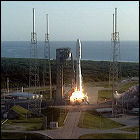 NASA launches the Perseverance Rover on its way to the planet Mars atop an Atlas V rocket. Though built around an assembly of flight spares left over from the Curosity Rover, Perseverance (known more formally as the Mars 2020 Rover) carries new experiments, including an ability to gather soil samples and seal them for pickup and return to Earth by a later (as yet unannounced) mission, over 20 built-in cameras, and – in a first for planetary exploration – a microphone designed to record the sounds of the Martian environment. Also attached to Perseverance is a drone, Ingenuity, designed for independent flight in the Martian atmosphere. Perseverance is aimed at Jezero Crater, an environment where liquid surface water is believed to have existed in Mars’ distant past, with a February 2021 landing date. The vehicle alarms ground controllers by going into a “safe mode” after launch, but communications and telemetry resume shortly afterward.
NASA launches the Perseverance Rover on its way to the planet Mars atop an Atlas V rocket. Though built around an assembly of flight spares left over from the Curosity Rover, Perseverance (known more formally as the Mars 2020 Rover) carries new experiments, including an ability to gather soil samples and seal them for pickup and return to Earth by a later (as yet unannounced) mission, over 20 built-in cameras, and – in a first for planetary exploration – a microphone designed to record the sounds of the Martian environment. Also attached to Perseverance is a drone, Ingenuity, designed for independent flight in the Martian atmosphere. Perseverance is aimed at Jezero Crater, an environment where liquid surface water is believed to have existed in Mars’ distant past, with a February 2021 landing date. The vehicle alarms ground controllers by going into a “safe mode” after launch, but communications and telemetry resume shortly afterward.
China launches Tianwen-1 toward Mars
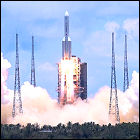 China launches the uncrewed Tianwen-1 space probe atop a Long March 5 rocket from the launch facilities in Wenchang. Intended to achieve orbit around Mars in February 2021, the spacecraft includes an orbiter and a lander/rover; the orbiter will look for suitable landing sites for the lander/rover combo, which is not expected to be dropped off until April 2021. The rover has soil gathering and analysis capabilities, while the orbiter has ground-penetrating radar. Tianwen-1 is intended to take up the unfulfilled mission objectives of the Yinghuo-1 orbiter, which was launched as a payload on Russia’s failed Fobos-Grunt mission in 2011 (which fell back into Earth’s atmosphere).
China launches the uncrewed Tianwen-1 space probe atop a Long March 5 rocket from the launch facilities in Wenchang. Intended to achieve orbit around Mars in February 2021, the spacecraft includes an orbiter and a lander/rover; the orbiter will look for suitable landing sites for the lander/rover combo, which is not expected to be dropped off until April 2021. The rover has soil gathering and analysis capabilities, while the orbiter has ground-penetrating radar. Tianwen-1 is intended to take up the unfulfilled mission objectives of the Yinghuo-1 orbiter, which was launched as a payload on Russia’s failed Fobos-Grunt mission in 2011 (which fell back into Earth’s atmosphere).
Emirates Mars Mission sends Hope to Mars
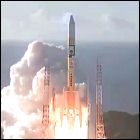 The United Arab Emirates launch their first uncrewed interplanetary mission, the Emirates Mars Mission, from Japan’s Tanegashima Space Center atop a Japanese H-IIA rocket. Expected to arrive at Mars in February 2021, the Hope orbiter will study Martian weather from orbit, not only serving as a true weather satellite for the red planet, but also gathering data on the factors leading to Martian atmosphere loss. The project, initiated in 2014, is intended not only to study Mars, but to attempt to gather a base of talent that could eventually build an Arab space industry.
The United Arab Emirates launch their first uncrewed interplanetary mission, the Emirates Mars Mission, from Japan’s Tanegashima Space Center atop a Japanese H-IIA rocket. Expected to arrive at Mars in February 2021, the Hope orbiter will study Martian weather from orbit, not only serving as a true weather satellite for the red planet, but also gathering data on the factors leading to Martian atmosphere loss. The project, initiated in 2014, is intended not only to study Mars, but to attempt to gather a base of talent that could eventually build an Arab space industry.
ExoMars Trace Gas Orbiter & Schiaparelli arrive
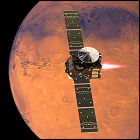 The European Space Agency’s ExoMars Trace Gas Orbiter and accompanying Schiaparelli Entry Demonstration Lander arrive at the red planet, with the orbiter successfully completing a lengthy engine burn to put it into orbit around Mars; it is the second ESA orbiter to reach Mars, with Mars Express still operating in an elliptical polar orbit. The lander, however, is not so lucky in reaching its goal: its signal, monitored both by the Trace Gas Orbiter and by Mars Express, abruptly ends near the surface; later analysis, and a Mars Reconnaissance Orbiter sighting of debris on Mars, lead ESA engineers to conclude that the lander’s parachute was jettisoned too soon, leaving it to plummet to the ground. This is but the first wave of an expected ExoMars program, a joint venture between ESA and the Russian space program.
The European Space Agency’s ExoMars Trace Gas Orbiter and accompanying Schiaparelli Entry Demonstration Lander arrive at the red planet, with the orbiter successfully completing a lengthy engine burn to put it into orbit around Mars; it is the second ESA orbiter to reach Mars, with Mars Express still operating in an elliptical polar orbit. The lander, however, is not so lucky in reaching its goal: its signal, monitored both by the Trace Gas Orbiter and by Mars Express, abruptly ends near the surface; later analysis, and a Mars Reconnaissance Orbiter sighting of debris on Mars, lead ESA engineers to conclude that the lander’s parachute was jettisoned too soon, leaving it to plummet to the ground. This is but the first wave of an expected ExoMars program, a joint venture between ESA and the Russian space program.
ExoMars
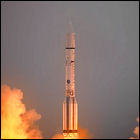 The European Space Agency’s unmanned Mars Trace Gas Orbiter, nicknamed ExoMars, lifts off via a Russian Proton rocket on a course for Mars. Carrying a small lander named Schiaparelli (named after the Italian astronomer who was instrumental in early mapping of Martian surface features via telescope), ExoMars is scheduled to arrive at the red planet in October 2016, deliver the Schiaparelli lander, and then enter orbit to search for traces and origins of methane in the Martian atmosphere, to determine if the presence of that gas – usually associated with biological activity on Earth – is geochemical in nature, or is derived from another source. Plans then call for ExoMars to join the fleet of artificial satellites relaying communications from current and future Mars-exploring rovers and landers to Earth through the 2020s.
The European Space Agency’s unmanned Mars Trace Gas Orbiter, nicknamed ExoMars, lifts off via a Russian Proton rocket on a course for Mars. Carrying a small lander named Schiaparelli (named after the Italian astronomer who was instrumental in early mapping of Martian surface features via telescope), ExoMars is scheduled to arrive at the red planet in October 2016, deliver the Schiaparelli lander, and then enter orbit to search for traces and origins of methane in the Martian atmosphere, to determine if the presence of that gas – usually associated with biological activity on Earth – is geochemical in nature, or is derived from another source. Plans then call for ExoMars to join the fleet of artificial satellites relaying communications from current and future Mars-exploring rovers and landers to Earth through the 2020s.
Mangalayaan arrives at Mars
 The unmanned Mangalayaan space probe arrives, intact and functioning, in Mars orbit, making India the first country on Earth to successfully reach Mars on its first attempt. (A high failure rate among past Mars missions has plagued both the Russian and American space programs.) A 23-minute engine burn slows Mangalayaan down enough to be captured by Mars’ gravity, but leaves the vehicle with twice the fuel reserves expected for its projected six-month mission.
The unmanned Mangalayaan space probe arrives, intact and functioning, in Mars orbit, making India the first country on Earth to successfully reach Mars on its first attempt. (A high failure rate among past Mars missions has plagued both the Russian and American space programs.) A 23-minute engine burn slows Mangalayaan down enough to be captured by Mars’ gravity, but leaves the vehicle with twice the fuel reserves expected for its projected six-month mission.
Mangalayaan to Mars
 India launches its first deep space unmanned mission, sending the Mangalayaan probe toward the planet Mars. Using the proven Polar Satellite launcher, India’s entry into the field of interplanetary exploration runs up a bill equivalent to only $70,000,000. Mangalayaan – known to much of the rest of the world as MOM (Mars Orbiter Mission) – is designed to survey the Martian atmosphere and examine the planet’s surface from orbit. It will arrive at Mars ten months later.
India launches its first deep space unmanned mission, sending the Mangalayaan probe toward the planet Mars. Using the proven Polar Satellite launcher, India’s entry into the field of interplanetary exploration runs up a bill equivalent to only $70,000,000. Mangalayaan – known to much of the rest of the world as MOM (Mars Orbiter Mission) – is designed to survey the Martian atmosphere and examine the planet’s surface from orbit. It will arrive at Mars ten months later.
Curiosity rover lands on Mars
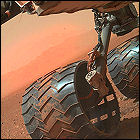 Surviving a previously untested landing method involving a rocket-firing sky crane, NASA’s Curiosity rover (or, more formally, the Mars Science Laboratory) lands safely on Mars, at the base of a mountain near Gale Crater. The first images from the surface arrive within seconds of landing, confirming the safe delivery of NASA’s latest mobile Mars explorer. The landing is especially suspenseful due to the “seven minutes of terror” – the one-way time for a signal to reach Earth from Mars – and the fact that the entire reentry and landing procedure takes 14 minutes.
Surviving a previously untested landing method involving a rocket-firing sky crane, NASA’s Curiosity rover (or, more formally, the Mars Science Laboratory) lands safely on Mars, at the base of a mountain near Gale Crater. The first images from the surface arrive within seconds of landing, confirming the safe delivery of NASA’s latest mobile Mars explorer. The landing is especially suspenseful due to the “seven minutes of terror” – the one-way time for a signal to reach Earth from Mars – and the fact that the entire reentry and landing procedure takes 14 minutes.
Mars Science Laboratory launched
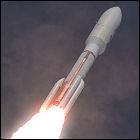 The Mars Science Laboratory mission is launched toward the red planet on an Atlas V rocket. The ambitious unmanned mission is intended to deposit a car-sized, nuclear-powered rover, nicknamed Curiosity, on the surface of Mars for an extended survey of the planet’s surface. Heavier than any of its predecessors, Curiosity will use an unprecedented means of slowing itself for descent, dangling from a “sky crane” for a soft touchdown after descending through the Martian atmosphere behind a protective heat shield.
The Mars Science Laboratory mission is launched toward the red planet on an Atlas V rocket. The ambitious unmanned mission is intended to deposit a car-sized, nuclear-powered rover, nicknamed Curiosity, on the surface of Mars for an extended survey of the planet’s surface. Heavier than any of its predecessors, Curiosity will use an unprecedented means of slowing itself for descent, dangling from a “sky crane” for a soft touchdown after descending through the Martian atmosphere behind a protective heat shield.
Spirit signs off
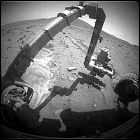 NASA’s Spirit Mars rover makes its last contact with ground controllers on Earth. With the Martian winter fast approaching, and the rover’s wheels leaving it stuck in an unfavorable position to keep its solar panels angled toward the sun, Spirit gradually loses power until it shuts off, its mission having lasted nearly seven and a half years – almost 30 times its original design and mission lifespan of 90 days. Spirit’s ground controllers are reassigned to either Opportunity (which is still mobile and operating) or the upcoming Mars Science Laboratory Curiosity rover mission.
NASA’s Spirit Mars rover makes its last contact with ground controllers on Earth. With the Martian winter fast approaching, and the rover’s wheels leaving it stuck in an unfavorable position to keep its solar panels angled toward the sun, Spirit gradually loses power until it shuts off, its mission having lasted nearly seven and a half years – almost 30 times its original design and mission lifespan of 90 days. Spirit’s ground controllers are reassigned to either Opportunity (which is still mobile and operating) or the upcoming Mars Science Laboratory Curiosity rover mission.
Spirit’s sticky situation
 NASA’s Spirit Mars rover becomes stuck in an area of soft, dusty soil in which its wheels can no longer gain traction. Efforts to simulate the problem on Earth begin, as well as studies to see if Spirit can free itself, but attempts to wiggle or rotate the rover’s wheels on Mars produce no results (and eventually wear out the independent motor of another of its wheels). The attempts to free Spirit from its Martian sandtrap continue through early 2010.
NASA’s Spirit Mars rover becomes stuck in an area of soft, dusty soil in which its wheels can no longer gain traction. Efforts to simulate the problem on Earth begin, as well as studies to see if Spirit can free itself, but attempts to wiggle or rotate the rover’s wheels on Mars produce no results (and eventually wear out the independent motor of another of its wheels). The attempts to free Spirit from its Martian sandtrap continue through early 2010.
Phoenix finds water on Mars, but toxic soil
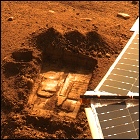 NASA’s Phoenix lander samples the soil of Mars, and it finds not only water, but an unusual soil composition which would make living off the land unlikely for human travelers. The soil sample in question contains perchlorate, a chemical used on Earth to make solid rocket fuel. So while a hypothetical Mars colony couldn’t use the planet’s own soil for farming, it could certainly launch a rocket or two. But missions scientists are quick to point out that while the presence of perchlorate in the Martian dirt may be unfriendly to humans, there may still have been life on the planet at some point which adapted to that chemical; it may also be a localized phenomenon unique to Phoenix’s polar landing site. (There are some plants on Earth capable of processing perchlorate-infused soil, but they’re generally not regarded as viable crops.) The Phoenix probe’s mission is extended to the end of September so it can continue its studies, and could be extended again at the end of that period, though the harsh Martian winter is likely to deny the non-roving Phoenix the kind of longevity enjoyed by its more mobile siblings, Spirit and Opportunity.
NASA’s Phoenix lander samples the soil of Mars, and it finds not only water, but an unusual soil composition which would make living off the land unlikely for human travelers. The soil sample in question contains perchlorate, a chemical used on Earth to make solid rocket fuel. So while a hypothetical Mars colony couldn’t use the planet’s own soil for farming, it could certainly launch a rocket or two. But missions scientists are quick to point out that while the presence of perchlorate in the Martian dirt may be unfriendly to humans, there may still have been life on the planet at some point which adapted to that chemical; it may also be a localized phenomenon unique to Phoenix’s polar landing site. (There are some plants on Earth capable of processing perchlorate-infused soil, but they’re generally not regarded as viable crops.) The Phoenix probe’s mission is extended to the end of September so it can continue its studies, and could be extended again at the end of that period, though the harsh Martian winter is likely to deny the non-roving Phoenix the kind of longevity enjoyed by its more mobile siblings, Spirit and Opportunity.
Phoenix successfully lands on Mars
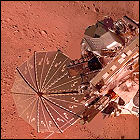 Radio signals from the Martian surface indicating the successful landing of NASA’s unmanned Phoenix probe near the north pole of Mars. (To put this feat in perspective: the past several unmanned probes to land safely on Mars used a “bouncing airbag” approach; the last time a lander actually made it to the surface intact with braking thrusters and landing pads – and no airbags – was in 1976, when NASA’s Viking 1 and 2 landers successfully touched down on the planet.) The first stationary (i.e. non-rover) Mars lander since the Viking probes of the 1970s, Phoenix will stay in one spot to conduct three months of studies. Also like the Vikings, Phoenix has a soil-sampling arm and an on-board laboratory to help it determine the presence of water or water ice in its polar vicinity.
Radio signals from the Martian surface indicating the successful landing of NASA’s unmanned Phoenix probe near the north pole of Mars. (To put this feat in perspective: the past several unmanned probes to land safely on Mars used a “bouncing airbag” approach; the last time a lander actually made it to the surface intact with braking thrusters and landing pads – and no airbags – was in 1976, when NASA’s Viking 1 and 2 landers successfully touched down on the planet.) The first stationary (i.e. non-rover) Mars lander since the Viking probes of the 1970s, Phoenix will stay in one spot to conduct three months of studies. Also like the Vikings, Phoenix has a soil-sampling arm and an on-board laboratory to help it determine the presence of water or water ice in its polar vicinity.
Mars in asteroid’s crosshairs
 Astronomers put the red planet on red alert after predicting 1-in-75 odds for an asteroid to collide with Mars on or near January 30th. The asteroid, discovered in November 2007, is on a trajectory that poses no threat to Earth but has better-than-usual odds of packing quite a wallop for Mars. The impact, if it does happen, could take place on the equator, near the Opportunity rover’s stomping (or, perhaps, roving) grounds, though NASA says it would pose no risk to Opportunity. A crater as large as Arizona’s Meteor Crater could be carved out of the Martian surface by any direct hit that does happen. Scientists prepare to watch the event with keen interest, as this event would be potentially cataclysmic if Earth was in danger, but provides a once-in-a-lifetime opportunity for observation on Mars.
Astronomers put the red planet on red alert after predicting 1-in-75 odds for an asteroid to collide with Mars on or near January 30th. The asteroid, discovered in November 2007, is on a trajectory that poses no threat to Earth but has better-than-usual odds of packing quite a wallop for Mars. The impact, if it does happen, could take place on the equator, near the Opportunity rover’s stomping (or, perhaps, roving) grounds, though NASA says it would pose no risk to Opportunity. A crater as large as Arizona’s Meteor Crater could be carved out of the Martian surface by any direct hit that does happen. Scientists prepare to watch the event with keen interest, as this event would be potentially cataclysmic if Earth was in danger, but provides a once-in-a-lifetime opportunity for observation on Mars.
Rosetta at Mars
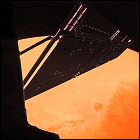 ESA’s unmanned Rosetta space probe, carrying the Philae lander bound for a 2014 rendezvous with Comet 67/P Churyumov–Gerasimenko, makes a gravity-assist flyby of planet Mars to alter its trajectory. As Rosetta will be only 160 miles from the Martian surface at its closest approach, the spacecraft is put into a safe mode for this critical part of its trip, and emerges unscathed. Its next gravity assist will come from Earth itself later in the year.
ESA’s unmanned Rosetta space probe, carrying the Philae lander bound for a 2014 rendezvous with Comet 67/P Churyumov–Gerasimenko, makes a gravity-assist flyby of planet Mars to alter its trajectory. As Rosetta will be only 160 miles from the Martian surface at its closest approach, the spacecraft is put into a safe mode for this critical part of its trip, and emerges unscathed. Its next gravity assist will come from Earth itself later in the year.
Mars Rovers’ mission extended
 NASA announces that the Spirit rover has exceeded its mission goals of 90 continuous Martian days of operation since landing, with over 600 meters of the Martian surface covered. NASA applies for, and receives approval on, a plan to keep Spirit and Opportunity roving through September, almost tripling the rovers’ planned life span. The extended mission, made possible by a budget boost of $15 million, will give engineers the chance to try handing control over to the Rovers’ built-in systems, and it’ll afford a greater opportunity to examine the unusual rocks and evidence of past bodies of water on the Martian surface.
NASA announces that the Spirit rover has exceeded its mission goals of 90 continuous Martian days of operation since landing, with over 600 meters of the Martian surface covered. NASA applies for, and receives approval on, a plan to keep Spirit and Opportunity roving through September, almost tripling the rovers’ planned life span. The extended mission, made possible by a budget boost of $15 million, will give engineers the chance to try handing control over to the Rovers’ built-in systems, and it’ll afford a greater opportunity to examine the unusual rocks and evidence of past bodies of water on the Martian surface.
Not just water, but salt water, on Mars
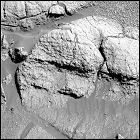 NASA scientists unveil new findings from the two Mars Exploration Rovers, Spirit and Opportunity. While both rovers have found evidence of water erosion in rocks at their respective landing sites, the scientists now say that Opportunity’s landing site – a large crater – features rocks which show conclusive evidence of a large body of salt water, not unlike Earth’s oceans. While no definitive signs of life have been found by Opportunity or its identical twin, these findings continue to add up to a picture of Mars as a place where life once could have thrived.
NASA scientists unveil new findings from the two Mars Exploration Rovers, Spirit and Opportunity. While both rovers have found evidence of water erosion in rocks at their respective landing sites, the scientists now say that Opportunity’s landing site – a large crater – features rocks which show conclusive evidence of a large body of salt water, not unlike Earth’s oceans. While no definitive signs of life have been found by Opportunity or its identical twin, these findings continue to add up to a picture of Mars as a place where life once could have thrived.
Opportunity lands on Mars
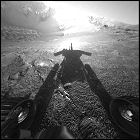 The Opportunity rover, identical to Spirit, lands on schedule and on target in Mars’ Meridiani Planum region, but initial readings from the surface of Mars indicate that the landing pod containing Opportunity has come to rest on its side. Telemetry signals from Opportunity announce that the the rover has arrived safely and intact, ready to begin its mission, and the opening of the landing vehicle returns Opportunity to its intended upright position. As with Spirit, Opportunity will remain on its landing platform for several days undergoing a series of diagnostic tests before rolling off to the Martian surface for independent exploration, and engineers are keeping a close eye out for signs of a computer problem that has plagued Spirit for several days.
The Opportunity rover, identical to Spirit, lands on schedule and on target in Mars’ Meridiani Planum region, but initial readings from the surface of Mars indicate that the landing pod containing Opportunity has come to rest on its side. Telemetry signals from Opportunity announce that the the rover has arrived safely and intact, ready to begin its mission, and the opening of the landing vehicle returns Opportunity to its intended upright position. As with Spirit, Opportunity will remain on its landing platform for several days undergoing a series of diagnostic tests before rolling off to the Martian surface for independent exploration, and engineers are keeping a close eye out for signs of a computer problem that has plagued Spirit for several days.
Spirit’s murky memory
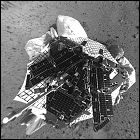 JPL engineers begin experiencing severe difficulty communicating with the Spirit Mars rover, which had successfully rolled off of its landing platform the previous week. Just as the rover is ready to begin its travels on the surface of Mars, it stops communicating with Earth, or with any orbiting spacecraft overhead. A command is transmitted to force Spirit to report its condition, and the resulting telemetry indicates that the rover has been continuously rebooting its internal computer system. By the weekend, after worries and warnings that Spirit would probably never regain 100% functionality, JPL’s engineers re-establish communications and received enough diagnostic information to narrow the problem down to Spirit’s flash memory and handling software. Engineers soon resolve the problem, transmitting instructions to work around the potentially corrupted memory, and restoring Spirit so it can continue its exploration.
JPL engineers begin experiencing severe difficulty communicating with the Spirit Mars rover, which had successfully rolled off of its landing platform the previous week. Just as the rover is ready to begin its travels on the surface of Mars, it stops communicating with Earth, or with any orbiting spacecraft overhead. A command is transmitted to force Spirit to report its condition, and the resulting telemetry indicates that the rover has been continuously rebooting its internal computer system. By the weekend, after worries and warnings that Spirit would probably never regain 100% functionality, JPL’s engineers re-establish communications and received enough diagnostic information to narrow the problem down to Spirit’s flash memory and handling software. Engineers soon resolve the problem, transmitting instructions to work around the potentially corrupted memory, and restoring Spirit so it can continue its exploration.
Spirit lands on Mars
 The first of two new American Mars rovers lands successfully on the red planet. The Mars rover Spirit enters the Martian atmosphere (and cleaves a path right through a dust storm), deploying thick layers of airbags that allow it to bounce safely until landing upright. This is the same landing system employed by the Pathfinder mission in 1997, but the unmanned robot probe in this case is much more sophisticated. Among the primary scientific objectives of Spirit’s mission is to determine if water existed on the surface of Mars for a significant length of time. The Spirit rover will undergo a series of diagnostics and won’t begin its mobile mission for several days. Its identical twin, a rover named Opportunity, will land in three weeks.
The first of two new American Mars rovers lands successfully on the red planet. The Mars rover Spirit enters the Martian atmosphere (and cleaves a path right through a dust storm), deploying thick layers of airbags that allow it to bounce safely until landing upright. This is the same landing system employed by the Pathfinder mission in 1997, but the unmanned robot probe in this case is much more sophisticated. Among the primary scientific objectives of Spirit’s mission is to determine if water existed on the surface of Mars for a significant length of time. The Spirit rover will undergo a series of diagnostics and won’t begin its mobile mission for several days. Its identical twin, a rover named Opportunity, will land in three weeks.
2003 Robot Hall Of Fame inductees

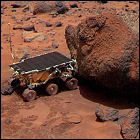 The first four inductees – two real and two fictional – are inducted into the Robot Hall Of Fame created by Carnegie Mellon University’s School of Computer Science.
The first four inductees – two real and two fictional – are inducted into the Robot Hall Of Fame created by Carnegie Mellon University’s School of Computer Science.
- Unimate (1961, General Motors) – the first robotic arm used in car assembly
- HAL-9000 (1968, from 2001: a space odyssey)
- R2-D2 (1977, from Star Wars)
- Sojourner (1996, NASA) – the first successful Mars rover
The panel of judges in future years will pare down the number of nominations awarded to fictional creations. R2-D2 actor Kenny Baker and Douglas Rains, the voice actor behind HAL, are in attendance.
Mars Odyssey arrives at the red planet
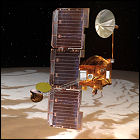 NASA’s 2001 Mars Odyssey probe reaches Mars and settles into an orbit which will gradually be corrected by aerobraking (using the friction of the planet’s atmosphere to slow the vehicle down). Unlike the Mars Surveyor mission, Odyssey does not contain a landing probe, but will instead look at the planet from orbit. Another unique feature of Odyssey’s mission plan is the fact that it won’t be shut down when its scientific investigation has come to an end; it will be left in Mars orbit to serve as a communications relay satellite for future missions.
NASA’s 2001 Mars Odyssey probe reaches Mars and settles into an orbit which will gradually be corrected by aerobraking (using the friction of the planet’s atmosphere to slow the vehicle down). Unlike the Mars Surveyor mission, Odyssey does not contain a landing probe, but will instead look at the planet from orbit. Another unique feature of Odyssey’s mission plan is the fact that it won’t be shut down when its scientific investigation has come to an end; it will be left in Mars orbit to serve as a communications relay satellite for future missions.
Pathfinder falls silent
 Its ability to recharge its power supply depleted, the Mars Pathfinder lander – now dubbed Sagan Memorial Station – ceases its transmissions to Earth, also cutting off communication with the Sojourner Mars rover. Originally intended for a month-long mission, Pathfinder and Sojourner last three times that long, and give scientists and engineers a wealth of data for planning the twin Mars Exploration Rovers. NASA declares the Pathfinder mission a complete success in early 1998.
Its ability to recharge its power supply depleted, the Mars Pathfinder lander – now dubbed Sagan Memorial Station – ceases its transmissions to Earth, also cutting off communication with the Sojourner Mars rover. Originally intended for a month-long mission, Pathfinder and Sojourner last three times that long, and give scientists and engineers a wealth of data for planning the twin Mars Exploration Rovers. NASA declares the Pathfinder mission a complete success in early 1998.
Red planet rover, please come over
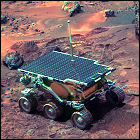 Sojourner, the original Mars rover, rides out on the Martian surface, getting close-up looks at nearby rocks and demonstrating technologies that are vital to upcoming Mars missions, including automatic hazard detection and avoidance. Sojourner’s ability to “see” obstacles and navigate around them without advice from ground controllers will be essential to later Mars rovers, since it takes seven minutes for a signal to reach Earth, and seven more minutes for instructions to return. The rover captures the public imagination and is even immortalized as a Hot Wheels toy.
Sojourner, the original Mars rover, rides out on the Martian surface, getting close-up looks at nearby rocks and demonstrating technologies that are vital to upcoming Mars missions, including automatic hazard detection and avoidance. Sojourner’s ability to “see” obstacles and navigate around them without advice from ground controllers will be essential to later Mars rovers, since it takes seven minutes for a signal to reach Earth, and seven more minutes for instructions to return. The rover captures the public imagination and is even immortalized as a Hot Wheels toy.
Pathfinder bounces onto Mars
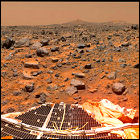 Using a never-before-attempted system of landing, the Mars Pathfinder unmanned probe employs an aerobraking maneuver to slow down in the planet’s atmosphere, and an all-encompassing layer of airbags to “bounce” onto the surface without using rockets to slow the vehicle down. The weighted landing station rolls to the correct orientation, deflates the airbags, and deploys on schedule, proving the merits of a landing technique that will deliver future Mars landers already in the planning stages.
Using a never-before-attempted system of landing, the Mars Pathfinder unmanned probe employs an aerobraking maneuver to slow down in the planet’s atmosphere, and an all-encompassing layer of airbags to “bounce” onto the surface without using rockets to slow the vehicle down. The weighted landing station rolls to the correct orientation, deflates the airbags, and deploys on schedule, proving the merits of a landing technique that will deliver future Mars landers already in the planning stages.
Pathfinder en route to Mars
 NASA/JPL’s low-cost Mars Pathfinder mission lifts off for a date with Mars. The first American Mars lander since the Viking missions of the 1970s, Pathfinder is practically an interplanetary tech demonstration, showing off new landing techniques (aerobraking and landing airbags), new lander designs (a fixed station delivering a wheeled “rover”), and the beginning of a new commitment to exploring Mars. By the time operations are wrapped up on the Pathfinder mission, the total amount of money spent is under $300,000,000.
NASA/JPL’s low-cost Mars Pathfinder mission lifts off for a date with Mars. The first American Mars lander since the Viking missions of the 1970s, Pathfinder is practically an interplanetary tech demonstration, showing off new landing techniques (aerobraking and landing airbags), new lander designs (a fixed station delivering a wheeled “rover”), and the beginning of a new commitment to exploring Mars. By the time operations are wrapped up on the Pathfinder mission, the total amount of money spent is under $300,000,000.
The future of Mars exploration
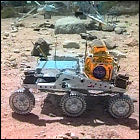 A tech demonstration at the Jet Propulsion Laboratory leads to a rethink of the upcoming Mars Environmental Survey mission (MESUR). A self-contained “rover” named Rocky IV convinces mission planners to include a similar rover on an upcoming Mars mission; although the rest of MESUR is eventually scrapped due to budget cuts, the one portion of it to be salvaged is the Mars Pathfinder lander, which will deliver the rover (later to be named Sojourner in a nationwide contest) to the Martian surface sometime in the late ’90s.
A tech demonstration at the Jet Propulsion Laboratory leads to a rethink of the upcoming Mars Environmental Survey mission (MESUR). A self-contained “rover” named Rocky IV convinces mission planners to include a similar rover on an upcoming Mars mission; although the rest of MESUR is eventually scrapped due to budget cuts, the one portion of it to be salvaged is the Mars Pathfinder lander, which will deliver the rover (later to be named Sojourner in a nationwide contest) to the Martian surface sometime in the late ’90s.
Phobos 2 and the curse of Mars
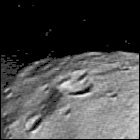 The Soviet Union loses all contact with the unmanned Mars probe Phobos 2 during a close flyby of the inner Martian moon Phobos, where the vehicle had been programmed to deposit a pair of surface landers. Unable to reacquire communications with Phobos 2, Soviet ground controllers later discover a fatal error in the programming of the probe’s on-board computer, leading to a loss of attitude control similar to the incident that doomed Phobos 1 in 1988. Since delivery of the landers never occurs, the mission is deemed a failure.
The Soviet Union loses all contact with the unmanned Mars probe Phobos 2 during a close flyby of the inner Martian moon Phobos, where the vehicle had been programmed to deposit a pair of surface landers. Unable to reacquire communications with Phobos 2, Soviet ground controllers later discover a fatal error in the programming of the probe’s on-board computer, leading to a loss of attitude control similar to the incident that doomed Phobos 1 in 1988. Since delivery of the landers never occurs, the mission is deemed a failure.
Phobos 2 arrives at Mars
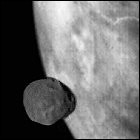 The Soviet Union’s unmanned Mars probe Phobos 2 successfully arrives in orbit around the red planet after over half a year of interplanetary travel (and after the loss of its identical twin, Phobos 1). Phobos 2 begins taking pictures of both Mars and Phobos and begins a series of orbital maneuvers that will eventually lead it to a very close approach to Phobos, where it is expected to release a pair of surface landers, the first of their kind to study a Martian moon.
The Soviet Union’s unmanned Mars probe Phobos 2 successfully arrives in orbit around the red planet after over half a year of interplanetary travel (and after the loss of its identical twin, Phobos 1). Phobos 2 begins taking pictures of both Mars and Phobos and begins a series of orbital maneuvers that will eventually lead it to a very close approach to Phobos, where it is expected to release a pair of surface landers, the first of their kind to study a Martian moon.
Phobos 1 and the curse of Mars
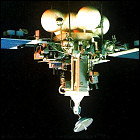 The Soviet Union loses contact with the Phobos 1 unmanned Mars probe during its interplanetary flight and is unable to re-establish contact. The cause of the vehicle’s loss is later traced to a typo in a single line of command code uplinked to its computer from the ground; this error changes a routine command to a command to shut down attitude control, leaving Phobos 1 tumbling through space, unable to point its antenna toward Earth. The mission is a complete loss.
The Soviet Union loses contact with the Phobos 1 unmanned Mars probe during its interplanetary flight and is unable to re-establish contact. The cause of the vehicle’s loss is later traced to a typo in a single line of command code uplinked to its computer from the ground; this error changes a routine command to a command to shut down attitude control, leaving Phobos 1 tumbling through space, unable to point its antenna toward Earth. The mission is a complete loss.